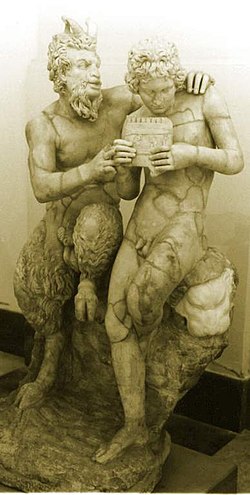Daphnis

In Greek mythology, Daphnis (/ˈdæfnɪs/; Ancient Greek: Δάφνις, from δάφνη, daphne, "Bay Laurel"[1]) was a Sicilian shepherd who was said to be the inventor of pastoral poetry.[2][3]
Family[]
According to tradition, he was the son of Hermes and a nymph,[3] despite which fact Daphnis himself was mortal.
Mythology[]
Daphnis was also described and shown as an eromenos. His mother was said to have exposed him under a laurel tree, where he was found by shepherds and named after the tree under which he was found. He was also sometimes said to be Hermes' favourite or beloved rather than his son.
A naiad (possibly Echenais or Nomia) was in love with him and promised to be faithful to him. However, he was seduced, with the aid of wine, by the daughter of a king, and, in revenge, this nymph either blinded him[3] or turned him to stone. Pan also fell in love with him and taught him to play the pan flute.[4]
Daphnis, who endeavoured to console himself by playing the flute and singing shepherds' songs, soon afterwards died. He fell from a cliff, or was changed into a rock, or was taken up to heaven by his father Hermes, who caused a spring of water to gush out from the spot where his son had been carried off. Ever afterwards the Sicilians offered sacrifices at this spring as an expiatory offering for the youth's early death. There is little doubt that Aelian in his account follows Stesichorus of Himera, who in like manner had been blinded by the vengeance of a woman (Helen) and probably sang of the sufferings of Daphnis in his recantation. Nothing is said of Daphnis's blindness by Theocritus, who dwells on his amour with Nais; his victory over Menalcas in a poetical competition; his love for Xenea brought about by the wrath of Aphrodite; his wanderings through the woods while suffering the torments of unrequited love; his death just at the moment when Aphrodite, moved by compassion, endeavours (but too late) to save him; the deep sorrow, shared by nature and all created things, for his untimely end (Theocritus i. vii. viii.). A later form of the legend identifies Daphnis with a Phrygian hero, and makes him the teacher of Marsyas. The legend of Daphnis and his early death may be compared with those of Hyacinthus, Narcissus, Linus and Adonis—all beautiful youths cut off in their prime, typical of the luxuriant growth of vegetation in the spring, and its sudden withering away beneath the scorching summer sun.[5]
Daphnis was also the name of a member of the group of Prophetic sisters, known as the Thriae.
Cultural depictions[]
- Daphnis is the subject of Theocritus's first Idyll.
- Longus's prose tale of Daphnis and Chloe describes two children who grow up together and gradually develop mutual love, eventually marrying after many adventures.
- Maurice Ravel wrote the 1912 ballet Daphnis et Chloé for Sergei Diaghilev's Ballets Russes. The scenario was adapted by Michel Fokine from the romance by Longus.
Notes[]
- ^ "δάφνη", Henry George Liddel, Robert Scott, A Greek-English lexicon, 9th ed., 1940, Oxford University Press.
- ^ "Daphnis" The Oxford Companion to Classical Literature. Edited by M. C. Howatson. Oxford University Press Inc. Oxford Reference Online. Oxford University Press. 16 June 2012
- ^ Jump up to: a b c Chisholm, Hugh, ed. (1911). . Encyclopædia Britannica. 7 (11th ed.). Cambridge University Press. p. 826.
- ^ Clement, Homilies 5.16
- ^ One or more of the preceding sentences incorporates text from a publication now in the public domain: Chisholm, Hugh, ed. (1911). "Daphnis". Encyclopædia Britannica. 7 (11th ed.). Cambridge University Press. p. 826.
External links[]
- Daphnis Encyclopædia Britannica
- The Death of Daphnis A poem by Theocritus
| Wikimedia Commons has media related to Daphnis (mythology). |
- Children of Hermes
- Sicilian characters in Greek mythology
- Pan (god)
- Metamorphoses in Greek mythology
- LGBT themes in Greek mythology